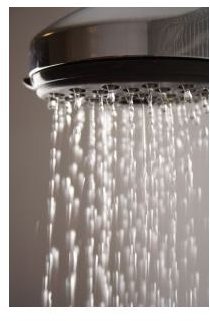5 Tips for Saving Water in Shower Use
The bathroom is where 75% of the water usage occurs in the average American household, and nearly one-fifth of a household’s water goes down the drain in the shower. If you’d like to work on cutting that figure and conserving water, try these tips for saving water in shower usage.
Install a Water-Efficient, Low-Flow Showerhead
Every home built since 1992 already has a low-flow water saving shower head by law. This means it puts out 2.5 gallons per minute (gpm) rather than the 5 gpm that is standard in regular, “high flow” showerheads. As you can imagine, low-flow showerheads save at least 50% of the water used in showers of the same length. A standard 10-minute shower with an old showerhead uses 50 (fifty!) gallons of water, while a 10-minute shower under a low-flow showerhead uses 25 gallons of water.
If you live in an older home and/or have never changed out your showerhead, swapping out to a low-flow is a great way to cut shower water usage in half instantly. Averaging only $10 to $20, this is one water conservation investment that will pay for itself — assuming you still take the same length showers! Low-flow showerheads that don’t compensate for the reduced water usage with added pressure often inspire people to take longer showers. Consider using a wind-up kitchen timer to keep yourself to your old shower schedule after changing to a low-flow showerhead until you get used to the new water flow rate.
Take Shorter Showers
Want to save 1,800 gallons of water a year? Take a one-minute shorter shower. Even better, grab that kitchen timer mentioned above and try taking five-minute showers. If you normally take ten-minute showers, that’s conserving 50% more water instantly.
You can push water savings even further if you turn on the water only when first getting wet and when rinsing. Turn off the water in the middle while you soap up and wash your hair.
Can’t Stand Short Showers? Take a Bath!
If you just can’t manage to cut shower time to five minutes, consider taking a bath instead. Remember, a ten-minute shower, even with a low-flow showerhead, will use 25 gallons of water. The average bathtub can be filled halfway with 20–25 gallons of water, a more than comfortable amount to bathe in. If you don’t mind a shallower tub, just put a few inches of water in, and soak to your heart’s content instead of rushing through a shower.
Keep a Bucket in or Near the Shower
What? Why keep a bucket in the shower? To catch the cool water that runs before your shower warms up, of course. Normally that water would go down the drain. Let it flow into a bucket, and use it to water plants or to flush the toilet.
Shower Less Often
Sound icky? It isn’t terrible once you think about it. If you work an office job and aren’t working up a sweat, chances are you aren’t getting very dirty every day. If you want to get super-serious about water conservation, try taking a sponge bath occasionally instead of a bath or shower.
From the simple (replacing showerheads) to the dedicated (sponge baths, anyone?), there are several tips for saving water in shower usage that one can put to use. Think positively: try just a one or two minute reduction in shower time to begin with, and think about the other tips and how they might help you to conserve water and keep our fresh water resources abundant.
References
https://www.energysavers.gov/your_home/water_heating/index.cfm/mytopic=13050
https://www.conservewater.utah.gov/IndoorUse/Bathroom/
https://www.tampagov.net/dept_Water/information_resources/saving_water/110_Ways_to_Save_Water.asp
https://www.greensboro-nc.gov/residents/waystoconserve.htm
https://www.epa.gov/WaterSense/pubs/indoor.html
https://www.extension.umn.edu/distribution/naturalresources/components/DD6946r.html
